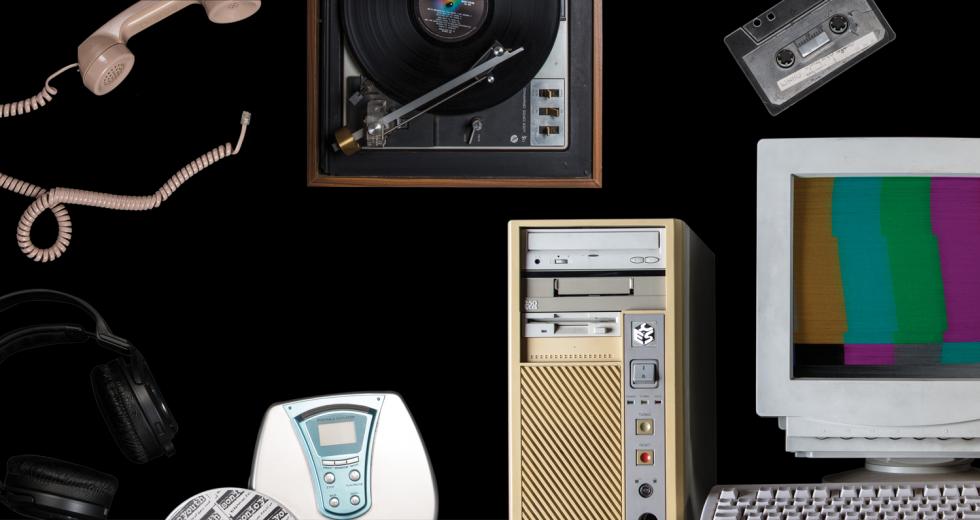There’s a great scene in the show Louie. The glum comedian, Louis C.K., brings his young daughter to a play in Manhattan. Moved by the performance, he fights back tears. His daughter watches the play, too, and then flicks her eyes to her smartphone. Louis is outraged. When the play is over he snaps at her, “Give me your phone.”
“Why?” she asks, innocent.
“I saw you! I saw you texting!”
Tired eyes? You can listen to the audio version of this article here:
The daughter patiently explains that she wasn’t texting, but was fully engrossed in the play, and then, simultaneously, she looked up the playwright to find out more. “Did you know that this play was banned in Russia and in Israel?” she asks Louis. (He did not.) “Did you know that he rewrote the ending?” she asks. (He did not.) “Don’t you wonder what that original ending was?” Louis, astonished, hands her back the phone. Kids these days.
Now imagine that the baffled Louis is Corporate America, and that his daughter is generation Z. Typically defined as anyone born since 1996, gen-Zers already account for one quarter of the U.S. population, and by 2020, they will make up 40 percent of all consumers. And while they might be young, they have power. “Don’t take their youth for granted,” cautions Dr. Corey Seemille in her book Generation Z Goes to College. “They are at an impressionable and inquisitive age in which they are busy forming perceptions of the companies, brands, products and marketing messages they encounter on a daily basis.”
In some ways they might already be an economic force. A 2014 study from the ad agency Sparks and Honey estimates that the average gen Z receives $16.90 per week in allowance alone, which tallies to an annual $44 billion in spending power. So who are these kids, anyway?
Leaders of the Pack
Think back to the first time you saw a smartphone. How old were you? Most gen-Zers cannot remember that moment. They have never known a world without Facebook or the iPhone, which is why they’re also called the “iGen” generation. They live and breathe technology.
“Many of these people have never made a phone call,” says Debi Hammond, CEO of Sacramento-based Merlot Marketing. “As marketers, we need to understand how they’ve been raised, how they use technology and how they interact with the social environment.”
Millennials are cord-cutters, yet gen Z has never known a cord. The average gen Z sends an astonishing 67 texts a day, according to the Pew Research Center. They’ve never had to drive a car without GPS. “There’s this perception that millennials are ‘tech-savvy,’ but they’re really just ‘tech-dependent.’ Gen Z is truly tech-savvy,” says Jason Dorsey, co-founder and researcher at the consulting firm The Center for Generational Kinetics. Dorsey has given TEDx talks on gen Z and pops up on places like 60 Minutes and CNBC to share generational factoids. “They only know technology, and they don’t know any other way to do things,” he says.
While millennials ushered in the much-ballyhooed “second-screen experience,” gen-Zers are more likely to use four or even five screens — laptop, TV, phone, tablet, kindle. Remember when “mobile banking” was a hot new thing? “For Gen Z there is no other kind of banking; it’s just banking,” Dorsey says.
And their behavior will impact our behavior. Grandma used to teach the children about the world, but now the kids teach Grandma how to use an iPad. “For the first time in history, the youngest generation is driving behavior of the older generations. The 15-year-old is doing something before the 50-year-old,” says Dorsey. “Without question, it’s very safe to say that within the next five years, gen Z will be the major driver of all key trends,” he says.
The Impact of Access
Gen Z’s techno-savvy isn’t just about scrolling through Snaps. Thanks to their hyper-access to news and video, “they are a more informed, curious generation,” Hammond says.
When I was in high school in the mid-’90s, I had a vague, fuzzy understanding that there was a genocide in Rwanda, yet it was too abstract to really sink in. Today’s high school students have a front row seat to the distant corners of the world, absorbing both its beauty and horrors. Were you moved by that image of a dead Syrian refugee boy? Imagine if you had seen it at age 14. Seventy-six percent of gen-Zers say they are concerned with humanity’s impact on the planet, according to Spark and Honey.
This heightened awareness brings with it an increased cynicism. A 2016 study from Edelman, the global communications firm with offices in Sacramento, found gen Z to be a highly skeptical cohort. In Edelman’s survey, only 36 percent of gen Z said they trusted businesses, compared to 67 percent of millennials and 64 percent of gen X. Trust in media is even lower: a paltry 26 percent, compared to 60 percent of millennials and 57 percent of gen X.
“This doesn’t mean that they’ve given up on the system, however,” says Edelman’s David Bersoff, who has been studying generational data for over a decade. He points out that gen Z also scores lowest for fear regarding topics like immigration, corruption and globalization, meaning they are (at this point) less likely to have a populist anger. Seemile’s research found that 72 percent of gen-Zers describe themselves as compassionate.
Gen Z is also a diverse bunch. Only 55 percent of the cohort is caucasian — compared to 72 percent of boomers — so they are not only comfortable with diversity, they expect diversity. Its absence can be jarring. “Diversity is the norm with gen Z,” Dorsey says. “Companies need to be really aware of the images and language they use. When the imagery is all white people, that doesn’t really connect with them.”
Skeptical Shoppers
This access to information also means gen-Zers tend to be smarter shoppers, shrewd decision-makers and a tougher sell. “When you’re talking to gen Z, remember that these are people who have grown up with information at their fingertips,” Hammond says. “They’re looking for transparency. They have good BS detectors. You can’t reach them by blowing smoke.”
While younger people are stereotyped as more financially irresponsible, gen Z is a frugal bunch. “Gen Z was old enough to see millennials struggling through the Great Recession,” explains Dorsey, as many were 10-12 years old when the housing market collapsed. They saw the stock market tank. “They saw their older brother drowning in college loans, unable to find a job and never able to buy his first home. Gen Z watched all this from the sidelines.”
This means that gen Z is more careful with a buck. For this cohort, it’s not just about what to buy, but if they should buy a product in the first place. For cynical, smart shoppers, paying per use makes more sense than one lump financial investment. The popularity of services like Uber and AirBnB may be just the beginning of a trend that will eventually dominate the consumer market.
“We’re going to see them do more of the non-traditional, pay-for-usage mode,” Dorsey says. “They’ll pay only when they want to use things.” Why squander $400 bucks a month on a car, insurance and fuel if you can instead live close to work, ride a bicycle and then splurge on the occasional Uber?
As shoppers, gen-Zers are less likely to be dazzled by a sexy brand and more prone to make a sensible purchase after clicking through several options. “Gen Z takes a more utilitarian, or pragmatic, approach to things like fashion or apparel,” Dorsey says. Philosophically, “they want to self-define, rather than let some brand define them. This gives them the freedom to be who they are.” So if you’re an apparel company, that could mean less focus on a logo and more focus on a solid sneaker.
A simple case study: Dollar Shave Club. “They took on an old industry that was dominated by the Gillette Brand, which spent millions and millions on Super Bowl ads,” explains Hammond. Tapping into the practicality that these gen-Zers crave, Dollar Shave Club stressed the merits of utility, convenience and affordability (and razors mailed to your home for a buck a month.) Less swoosh, more sneaker. They did it with plucky videos that went viral, as the Dollar Shave Club CEO dead-pans into the camera, “Are the blades any good? No. Our blades are f—–g great.” The video has over 23 million views on YouTube — and without spending a nickel on a Super Bowl ad.
Rules of Engagement
The Dollar Shave Club swung with a one-two punch: 1) a solid value proposition that appeals to gen Z’s utilitarianism; and 2) share-worthy visuals.
“Every bad customer service experience will — not ‘maybe,’ but will — be shared online.” Debbie Hammond, CEO, Merlot Marketing
“Shareability becomes a big part of a brand’s benefit,” Bersoff says. With gen Z, sharing on social media is not simply an added bonus, it’s a key part of the brand’s value, and brands should give the gen-Z consumer content that they can share. “If Red Bull has some event, it’s not just that gen Z wants to say ‘I was there and it was cool,’ but it allows them to relive the experience, maybe embellish it, and it becomes a part of the fabric of their social lives.”
And nothing gets shared quite like video. YouTube is now the second largest search engine behind Google, with more than 3 billion searches per month. “And if you look at Facebook’s algorithm, they serve up video at a faster pace than they do other content,” Hammond says. “This generation is incredibly visual –— they’re growing up with more images and fewer words.” Meaning how you look matters. Hammond says that brands must consider their visuals: “Your imagery, depending on what you’re trying to accomplish, needs to be beautiful, high quality, show-stopping, and it needs to tell a story.” She stresses this importance to her clients. “More than anything else, video is going to be the way to reach them.”
Gen Z has different expectations for customer service, too. “You have to respond immediately,” Hammond says. “For us 40-year-olds, you maybe expect a phone call within the next day. Gen Z expects a text or video response within minutes.” And if you flub the customer service? “Every bad customer service experience will — not ‘maybe,’ but will — be shared online,” Hammond says. She cites Zappos as a brand that gets it right: Customer service representatives respond to requests immediately and personalize the messages, signing the communication as with an actual name (from “John,” for example, not “Zappos customer service”).
More than anything, what the first truly tech-savvy generation wants is authenticity — and they have the tools to figure out pretty quickly if you’re faking it. “Good marketing is good marketing,” Hammond says. “Our tools change, and how we reach people changes, but when you’re talking to gen Z, they’re just looking for transparency. And great marketing is transparent.”
Recommended For You

Back and Forward: Debi Hammond on Marketing
Debi Hammond, the founder and CEO of Merlot Marketing in Sacramento, gives her insight into the marketing industry. For more from Hammond, check out “Dialing Up,” in our March issue. Sign up for our newsletter and we’ll email you when it’s available online.

Gen Z at Work
The oldest members of gen Z (born in 1996) are now graduating college, flooding offices across America with their cheery, five-screen-watching, can-do spirit.



